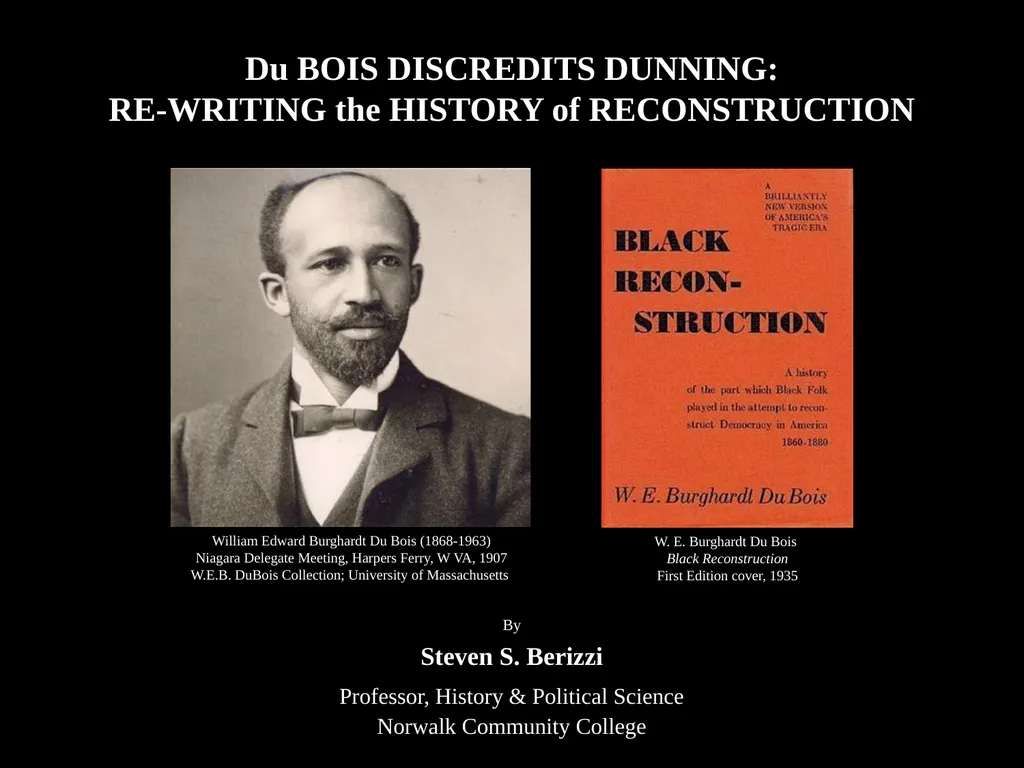Du BOIS DISCREDITS DUNNING: RE-WRITING the HISTORY
Author : stefany-barnette | Published Date : 2025-08-16
Description: Du BOIS DISCREDITS DUNNING REWRITING the HISTORY of RECONSTRUCTION By Steven S Berizzi Professor History Political Science Norwalk Community College William Edward Burghardt Du Bois 18681963 Niagara Delegate Meeting Harpers Ferry
Presentation Embed Code
Download Presentation
Download
Presentation The PPT/PDF document
"Du BOIS DISCREDITS DUNNING: RE-WRITING the HISTORY" is the property of its rightful owner.
Permission is granted to download and print the materials on this website for personal, non-commercial use only,
and to display it on your personal computer provided you do not modify the materials and that you retain all
copyright notices contained in the materials. By downloading content from our website, you accept the terms of
this agreement.
Transcript:Du BOIS DISCREDITS DUNNING: RE-WRITING the HISTORY:
Du BOIS DISCREDITS DUNNING: RE-WRITING the HISTORY of RECONSTRUCTION By Steven S. Berizzi Professor, History & Political Science Norwalk Community College William Edward Burghardt Du Bois (1868-1963) Niagara Delegate Meeting, Harpers Ferry, W VA, 1907 W.E.B. DuBois Collection; University of Massachusetts W. E. Burghardt Du Bois Black Reconstruction First Edition cover, 1935 Reconstruction 1865-1877 Reconstruction, an important era in United States history, arguably began on January 1, 1863, in the middle of the Civil War, when President Abraham Lincoln issued his final Emancipation Proclamation, in which he purported to free many, but not all, of nearly 4,000,000 enslaved people in 15 states. After the end of the War, three amendments to the U.S. Constitution were passed by Congress and ratified by the existing states. 1865: The Thirteenth Amendment abolished slavery in all states. 1868: The Fourteenth Amendment guaranteed the equal protection of the laws. 1870: The Fifteenth Amendment guaranteed voting rights for Black men. These constitutional amendments, and equally important, the statutes passed by Congress to enforce them, were the essence of the “Second American Revolution” of Reconstruction. Black Americans and their political allies had great hope that the nation would progress towards a multiracial democracy. Their great hope for a multiracial democracy proved to be short-lived. Resistance to Reconstruction reforms began almost immediately and often was violent. White supremacist organizations such as the Ku Klux Klan used terroristic tactics to intimidate Black Americans. Political barriers to political participation were raised by southern and northern White Democrats, both of whom had opposed President Lincoln’s policies throughout the Civil War. By the early 1870s, the political tides were turning against Reconstruction. All former states of the Confederacy were eventually “redeemed,” thereby restoring the control of state governments to conservative White Democrats. The redeemers drove Black officeholders from office, restricted the voting rights of Black men, and passed laws to segregate transportation, schools, and public accommodations. This became known as the “Jim Crow” Era. Origin of the “Jim Crow” Era The necessity of segregation was justified by a widespread belief that Reconstruction’s impulse for reform had been a failure, and was properly ended with the so-called Bargain of 1877, which resulted in removal of the remaining federal troops from the South. The absence of in-person daily federal oversight allowed the redeemers to expand their legal repression of Black Americans and control their labor. Slavery was not re-established, per se, but the effects











![[DOWNLOAD] - 180 Days of Writing for Sixth Grade - An Easy-to-Use Sixth Grade Writing](https://thumbs.docslides.com/901243/download-180-days-of-writing-for-sixth-grade-an-easy-to-use-sixth-grade-writing-workbook-to-practice-and-improve-writing-skills.jpg)
![[READ] - 180 Days of Writing for Fifth Grade - An Easy-to-Use Fifth Grade Writing Workbook](https://thumbs.docslides.com/901394/read-180-days-of-writing-for-fifth-grade-an-easy-to-use-fifth-grade-writing-workbook-to-practice-and-improve-writing-skills.jpg)
![[DOWNLOAD] - 180 Days of Writing for Kindergarten - An Easy-to-Use Kindergarten Writing](https://thumbs.docslides.com/901444/download-180-days-of-writing-for-kindergarten-an-easy-to-use-kindergarten-writing-workbook-to-practice-and-improve-writing-skills.jpg)
![[EBOOK] - 180 Days of Writing for First Grade - An Easy-to-Use First Grade Writing Workbook](https://thumbs.docslides.com/901798/ebook-180-days-of-writing-for-first-grade-an-easy-to-use-first-grade-writing-workbook-to-practice-and-improve-writing-skills.jpg)